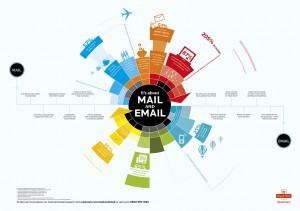 A decade ago, consumers’ mailboxes overflowed every day with a plethora of direct mail sent from every type of company you could think of. Today, our mailboxes are a lot less cluttered, and that’s a relief for mail recipients. The reason is simple — postage is expensive! However, direct mail isn’t dead yet.
A decade ago, consumers’ mailboxes overflowed every day with a plethora of direct mail sent from every type of company you could think of. Today, our mailboxes are a lot less cluttered, and that’s a relief for mail recipients. The reason is simple — postage is expensive! However, direct mail isn’t dead yet.
It could be argued that direct mail offers a significant opportunity to brands today simply because there is far less clutter in consumer mailboxes than there is online or in email in boxes. However, email is far more cost-effective and efficient, particularly when it comes to turnaround time, testing, and tracking. Brand managers can track the performance of an email marketing campaign by the second, by individual click, and more. Tracking direct mail is not quite as easy or accurate. It’s also incredibly easy to integrate email marketing into social media and content marketing initiatives. Again, it’s not quite as easy for direct mail.
Despite the reduction in the amount of direct mail consumers receive in their mailboxes these days, marketers are still looking for ways to guarantee their direct mail pieces stand out from the pile of bills and local car dealership postcards that arrive every day. Considering the fact that banks and financial companies continue to be some of the largest users of direct mail marketing, it’s not surprising that they’re also the ones that continually try to stand out from the crowd in an effort to communicate, “Don’t look at that other pre-approved credit card offer — look at me!”
Many of these companies are sending direct mail via overnight and express delivery carriers. For example, in the United States, companies are bypassing the United States Postal Service and sending direct mail via FedEx and UPS. Just a week or so ago, I received a mortgage-related offer from a financial institution via overnight delivery (not through the United States Postal Service) that I actually had to sign for. Not only is this an added expense for the sender, but in the United States, it can be illegal.
Direct mail is hanging on, but as consumers and media have evolved, so must direct mail. There are definitely still opportunities for brands to connect with consumers via direct mail campaigns, but the rules have changed. It’s not just about trying to stand out in a cluttered mailbox anymore. It’s about sending a really great offer and integrating that offer into your entire marketing plan (which includes online marketing, social media marketing, and even email marketing). We’re in an interesting phase of brand marketing evolution where an appropriate tagline might be, “Integrate or die.”
Image: stock.xchng
Susan Gunelius is the author of 10 marketing, social media, branding, copywriting, and technology books, and she is President & CEO of KeySplash Creative, Inc., a marketing communications company. She also owns Women on Business, an award-wining blog for business women. She is a featured columnist for Entrepreneur.com and Forbes.com, and her marketing-related articles have appeared on websites such as MSNBC.com, BusinessWeek.com, TodayShow.com, and more.
She has over 20 years of experience in the marketing field having spent the first decade of her career directing marketing programs for some of the largest companies in the world, including divisions of AT&T and HSBC. Today, her clients include large and small companies around the world and household brands like Citigroup, Cox Communications, Intuit, and more. Susan is frequently interviewed about marketing and branding by television, radio, print, and online media organizations, and she speaks about these topics at events around the world. You can connect with her on Twitter, Facebook, LinkedIn, or Google+.


